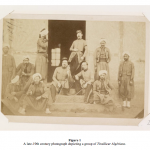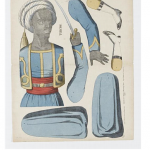11080 A LARGE LITHOGRAPHY BY FRÉDÉRIC CHARLES WENTZEL DEPICTING A TIRAILLEUR ALGÉRIAN French. Last Quarter Of The Nineteenth Century. Measurements: Sight Size: Height: 71″ (180.3 cm) Width: 17 1/4″ (43.8 cm). With Frame: Height: 75″ (190.5 cm) Width: 21″ (53.3 cm) Depth: 1 3/4″ (4.5 cm).

Research
Handcolored lithograph depicting an Algerian infantryman of the French Armée Afrique.
Marks:
Inscribed at the bottom:
Lith. de Fr. Wentzel a Wissembourg. Déposé DÉPôT V Humbert et Wentzel, rue St. Jacques, 65 PARIS.
Provenance:
Private Collection, New York City.
The present lithograph depicts a Tirailleur Algérian (Algerian sharphooter), a light infantryman of the Armée d’Afrique, which was developed by the French during the colonization of North Africa. The tirailleurs were officially created under the Second Empire in 1855 and were predominantly made up of native servicemen. The soldiers wore Zouave-style uniforms refered to as tenue oriental (Oriental dress), which comprised a blue jacket with yellow braiding worn over a sleeveless vest, blue harem trousers, a red sash at the waist and a fez or turban worn on the head. Algerian tirailleurs served in the Crimean war, the Second Italian War of Independence, the second Franco-Mexican war, and the Franco-Prussian War, as well as colonial campaigns in North Africa. They acquired the nickname Turcos (Turks) during the Crimean war, by which they were widely known over the following century. Figure 1 depicts a late 19th century photograph of a group of Tirailleur Algérians.
The lithograph was produced by the Wentzel family of lithographers. Jean Frédéric Wentzel was born in Wissembourg on October 15, 1807 and was trained as a bookbinder. Under Napoleon, the freedoms of the press were severely restricted and special permits were required to sell and produce printed materials. In order to obtain these permits one needed a certificate of good conduct from one’s mayor, as well as a “certificate of competence from four men of the same occupation.”1 Wentzel worked to obtain these documents over a twenty-year span; he received his brevet de libraire (bookselling permit) in 1832 and his brevet de lithographe (permit to produce lithographs) in 1835, from which point he lead his workshop in the printing of popular imagery of Wissembourg. He ultimately received his brevet d’imprimeur in 1851, which allowed him to print text.
Around 1855 Wentzel established a branch in Paris with the printer Nicolas Humbert at 65, rue St Jacques. After Humbert’s death in 1859, the partnership continued with his widow until Wentzel bought it outright in 1865. The firm reached its peak in the 1860s, during which time it comprised twenty lithographic printing presses producing 300 to 400 prints per day, and an estimated two million images per year in the best years of the decade.
The types of products produced by Wentzel and Humbert ranged from single prints to series representing contemporary life, biblical or mythological themes, patins (moveable paper dolls) and toy cutouts, such as optical illusions and miniature cardboard armies. They also manufactured large posters, like the present piece. These posters typically consisted of three strips and most measure 1.6 meters, equivalent to that of a human being.2 These life-size portraits depicted heroes of legends and fairy tales, historical figures, and military targets. Due to their size, it is likely that they were hung in pubic buildings sufficiently large to display them, probably the various “maisons des associations” created in the 19th century.3 The soldier was a major subject in French popular culture and Wentzel produced a patin of the same subject as well (figure 2).
Jean Frédéric died on 27 July 1869 and the business was taken over by his sons Frédéric Charles (1839-1877), who remained in Wissembourg, and Charles Frédéric (1833-1911), who operated the Paris branch. The Wissembourg workshop operated under the Wentzel family until 1889, when it was taken over by two German associates followed by René Ackerman in 1909.
Footnotes:
1. Hopkin, David M. Soldier and Peasant in French Popular Culture, 1766 – 1870. Woodbridge, Suffolk [u.a.: Royal Historical Soc, 2003. 34.
2. “Les Thèmes Illustrés Par L’imagerie De Wissembourg.” Des Mondes De Papier, L’imagerie Populaire De Wissembourg [ ]. N.p., n.d. Web. 21 Mar. 2014. <http://www.musees.strasbourg.eu/sites_expos/wissembourg/fr/index.php?page=0316>.
3. Ibid.



Comments are closed.